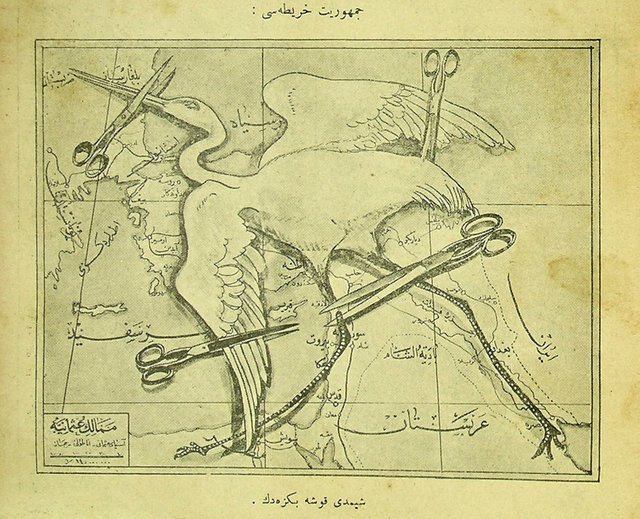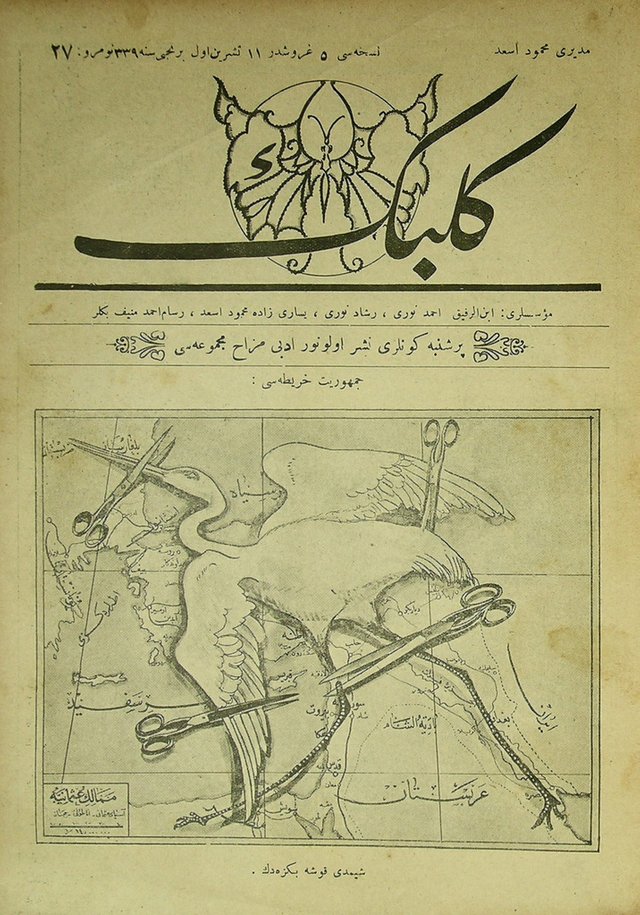117. Today in 1920s Turkey: 11 October 1923 (Geographic Vestigial Dismemberment)

(Cartoon by Ahmet Münif, Kelebek or “Butterfly,” 11 October 1923, no. 27, page 1.)
Türkçe:
(Üstte) Cumhuriyet Haritası:
(Altta) Şimdi kuşa benzedik.
English:
(Above) Map of the Republic:
(Below) Now we resemble a bird.
Comments
On Thursday, 11 October 1923 the weekly journal Kelebek featured a map of the new state’s borders as its cover-page illustration. The visually unconventional map has passed through the filter of a cartoonist’s hand, as it expresses far more than the mere boundaries of a state. Rather, it represents a very messy process. Through the analogy of a lanky stork transforming into a bird with more standard proportions, the short and not-so-sweet history of the nascent state is superimposed upon the standard map of its once mighty antecessor.
While the map’s legend in the lower left corner identifies it as Memalik-i Osmaniye or the Ottoman Empire, the title above the cartoon declares that it is a map of the Republic. The contradictory labels serve to communicate the transitional moment when one political entity ceases to exist and another is born. In this way, the new Turkey’s relationship to the old Ottoman Empire is established.
Even more imposing, however, is the visual, surgical transformation taking place before our eyes directly over the former Ottoman territories. Here, a single bird embodies two political entities, one a mutilated version of the other. Additional visual indicators of the image’s cartographic core can be found in the text identifying the various geographic regions located behind and around the bird’s body. The stork is a clever choice for a bird that can be manipulated into vaguely Ottoman-terrestrial form. As such, the Ottoman territories that would be lost over the course of the late 19th and early 20th century lie beneath the stork’s most characteristic features, mainly his bulky wings, long beak, and reed legs; while the remaining core areas of the bird’s body correspond to those of the new state.
The four unsettling sets of scissors constitute the method by which the bird’s transformation from a freakishly-spindly stork to a sensibly compact sparrow is completed. The sharp objects symbolize the blunt process by which this mutilation took place: war. International conflict was both the reason behind the loss of territories and the change in state and government. Although some of the territorial losses “cited” on the map had occurred as early as the 19th century, the final blow to Ottoman sovereignty was dealt in the aftermath of WWI whereby the Ottoman territories were partitioned between the Allied victors. The Turkish nationalist War of Independence that combated occupation served to restore some lost core territories to the state while dismantling the resident, defunct Ottoman administration and empire. And this is the sordid narrative behind the stork’s rather extensive surgical procedure.

(Entire cover page, Kelebek or “Butterfly,” 11 October 1923, no. 27, page 1.)
Additional Notes:
When this cartoon was originally published on 11 October 1923 the new Turkish state had not yet been declared a Republic. Indeed, that development would happen just a few weeks later on 29 October 1923. As such, the present cartoon was published in anticipation of a Republican outcome to the question on everyone’s mind: What Should We Name Our Country?.
For more examples of the artist Ahmet Münif’s work see the following posts from the past:
#1. Peace Cannons (2 August 1923)
#13. Back to School Edition (23 August 1923)
#26. Ankara Becomes Turkey’s New Capital City (18 October 1923)
Wow this is truly fascinating. I love how the cartoon depicts the transition, and how each detail tells a story not visible to the unassuming eye. It was a grand ambition from the cartoonist to create something like that which portrays the past, present and future. Are you a historian?
I agree, it is very satisfying in its complexity. You don't want a cartoon to be overloaded or overwhelming but this cartoon really strikes a balance. It's almost like the visual version of a pithy quote. The way he was able to string, like you say, past, present, and future together is so brilliant that it leaves me feeling like regular old maps are inadequate! What if all maps could tell the story of their country's borders with a zoomorphic analogy? Maybe more people would remember history that way:)
Oh, yes, and I am a historian, an art historian to be precise! I specialize in Turkish and Middle East art and history, especially the modern age. I received my PhD about a year and a half ago from Indiana University. Most of the materials and concepts I discuss here are by-products of my dissertation research.
I am completely with you on that! It's not the subject that students don't like, it's the way, and that goes for all school subjects. That's really interesting and a good combination; art and history. Do you know about the platform called medium? It's an option for you to publish your work, and they have about 100 million visitors a month. If you don't mind me asking, are you working in the field now?
I think there are many ways in which history could be better taught in schools... It's a shame it is not taken more seriously as a method of understanding the present, or maybe that is by design...
I've never hear of "medium" I'll have to check that out: that there are so many visitors is promising!
And yes, you read me fairly accurately: I am working in the field, but outside of academic institutions, with which I have lost much of my faith. I still attend conferences etc, but I'm no longer seeking "salvation" in the coveted "faculty position."
Broadly speaking, I am interested in sharing my research with a greater audience and on my own terms.
I agree, maybe the way it's taught is by design. I like what you said about no longer seeking 'salvation.' I am not sure why you lost your faith in them, but personally I stopped it before I reached that! I stopped my MA half way because I didn't see how it could add much value, and I plan to write about it in a future post. I highly respect your sensible approach to sharing your research. It's your work, and you should have the last and final say.
I look forward to seeing your post about leaving the MA, such a decision is not an easy one, and I'm curious about the back story.
The story of my own loss of faith in academia is multi-faceted and deeply connects with my own personal mission of making information "accessible" and free. I actually just started writing a multi-part essay answering just this question. It may be a while before it is "ready" but I'll pass it along when it is:)
Thanks. It actually wasn't as hard as I thought it'd be. Your approach is refreshing and I look forward to reading about your loss of faith in academia.
It is a very touching and graphic portrayal of the loss the author felt at the time. It is also a portrayal that doesn't age. It can be understood throughout the years and by a wide variety of people. The artist did an amazing work in this piece.
It is admirable that the artist was able to render something as ambivalent and clinical as a map with such rich commentary that relies on images rather than text. I'm really happy to see so much appreciation for this work so many years later:) It still resonates. We all still get it.
Very interesting content and sad too I am following you and have up voted this post kindly do the same for me thanks
Thank you. It is a little hard to look at if you really consider the years of trauma represented with the violent severing of the limbs--a result of many wars.
Excellent one. That humor is timeless. :) Bird and map fits perfect.
Anticipating the state as a republic is kind of surprising! It really anticipates the ongoing republic transition. However the sultanate was abolished at 1922 so I guess that the most of literate people anticipate that move.
For me the most surprising thing is journal's of that era were much more political and high profiled. Look at today's junks.
I agree, it hits all the notes just perfectly. And I don't know how the artist looked at an Ottoman map and was creative enough to see that bird and its relation to the new borders. It's an admirable composition altogether.
Re: the Republican chronology. You are correct, it would have been odd to see such a presumptuous or premature labeling perhaps a month or two ago, but by this time most people were pretty sure that the form of government would be a Republic (or that, at least it needed to be something because yes, there was no longer a sultan). Now, what people did not expect was the abolition of the Caliphate 4 months later in March 1924. That one was a surprise.
This post has been modified, updated, and re-posted on 11 October 2018. Access the new edition here.